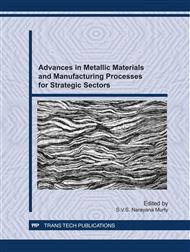p.527
p.533
p.539
p.545
p.551
p.557
p.563
p.569
p.575
Effect of Counter Surface Temperature and Load on the Transition from Mild to Severe Wear Behavior of Al-Si-SiCp Composites in Reciprocating Conditions
Abstract:
In the present paper, the effect of counter surface temperature and load on the transition from mild to severe wear of A319/15%SiCp, A336/15%SiCp, and A390/15%SiCp composites have been reported. Composites were produced through stir casting route. Adhesive wear behavior of composites was studied under dry reciprocating conditions using indigenously developed reciprocating friction wear test rig conforming to ASTM standard G133-05. It was found that increase in counter surface temperature increases wear rate and depending upon the load and type of composite mode of wear changes from mild oxidative to severe metallic wear noticed. At 120N load, the critical transition temperature for all the three Al-Si-SiCp composites was found to be 350°C. SEM study of wear surface and wear debris was conducted to analyze the mode of wear and operating wear mechanism. Severe wear was characterized by massive plastic deformation and gross material removal while the mild wear was found to be associated with delamination and scoring as main wear mechanisms responsible for material loss.
Info:
Periodical:
Pages:
551-556
Citation:
Online since:
January 2012
Authors:
Price:
Сopyright:
© 2012 Trans Tech Publications Ltd. All Rights Reserved
Share:
Citation:


